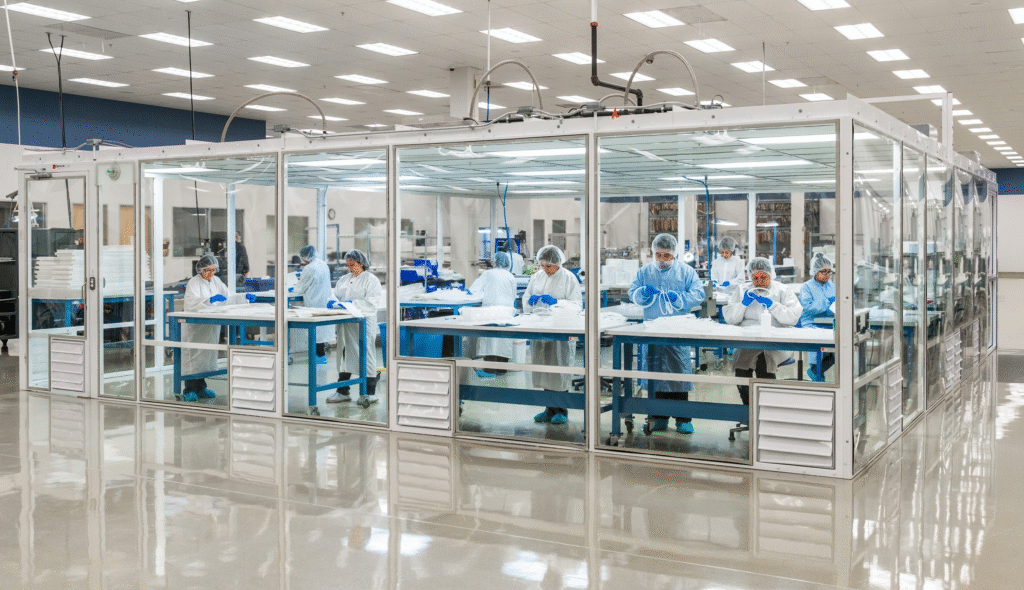
In the medical device industry, precision and cleanliness are not optional—they’re regulated requirements. A medical device cleanroom is a controlled environment specifically designed to minimize contamination during the manufacturing, assembly, and packaging of medical devices. These rooms play a vital role in protecting patient safety and ensuring compliance with international standards such as ISO 14644, FDA cGMP, and USP 797.
Why Cleanrooms Are Essential for Medical Devices
Medical devices often come into direct contact with human tissue or bodily fluids. Whether it’s an implantable stent or a diagnostic swab, any form of contamination—microbial, particulate, or chemical—can pose serious health risks.
Cleanrooms help reduce:
Airborne particulates
Microbial contamination
Cross-contamination between manufacturing zones
Electrostatic discharge and chemical residues
They provide a sterile or semi-sterile production zone that aligns with both regulatory requirements and clinical expectations.

Cleanroom Classifications for Medical Devices
Medical device cleanrooms are typically classified under the ISO 14644-1 standard, which limits the number and size of airborne particles.
| Application Scenario | Recommended ISO Class |
|---|---|
| Implantable device assembly, sterile packaging | ISO Class 5–7 |
| Syringe assembly, diagnostic kit packaging | ISO Class 7–8 |
| Bulk repackaging, non-sterile accessories | ISO Class 8 / Controlled Env. |
For reference: ISO 7 = 352,000 particles (≥0.5 μm) per m³; ISO 8 = 3.52 million particles per m³
These classifications are often defined by FDA’s cGMP guidelines (21 CFR 820.70), based on the product’s sterility requirements and contact risk.
Key Design Features
Medical device cleanrooms typically include:
HEPA filtration systems with 99.99% efficiency @ 0.3μm
FRP or HPL panel walls, easy to sanitize
Coved vinyl flooring for mop-down disinfection
Temperature & humidity control systems
Room-side replaceable filters for operational continuity
Airlocks, pass-through chambers, interlocked doors
Digital particle counters or magnehelic gauges for monitoring
Depending on the operation, features like air showers, gowning rooms, and clean benches may also be included.
Who Regulates Medical Device Cleanrooms?
In the United States, cleanrooms for medical devices are regulated by:
Many facilities undergo FDA inspections, and some require validation protocols such as IQ/OQ/PQ for critical processes and environments.
Real-World Use Cases

Medical device cleanrooms are used in:
Implantable devices (stents, pacemakers, orthopedic implants)
Injection-molded plastic components (for surgical tools or housings)
Diagnostic test kits (COVID, flu, pregnancy)
Wound care and drug delivery systems
Final product sterilization and sterile packaging lines
Suppliers to medical device brands (e.g., molders, packaging firms) are often required to maintain at least an ISO Class 8 cleanroom or higher.
Final Thoughts
Medical device cleanrooms are more than just clean spaces—they are regulated, engineered environments that directly impact patient safety. Whether you’re manufacturing surgical implants or diagnostic kits, investing in the right cleanroom setup is a regulatory necessity and a competitive advantage.
Frequently Asked Questions
Q: What cleanroom class is required for implantable devices?
Typically ISO 7 or better, to ensure sterility and prevent infection risks.
Q: Do medical device cleanrooms require air conditioning?
Yes. Controlled temperature and humidity are critical to meet both regulatory and process requirements.
Q: Are supplier cleanrooms also regulated?
Yes. Suppliers to medical device OEMs must often comply with the same ISO class depending on component criticality.
Q: What happens inside the cleanroom?
Assembly, inspection, sterilization, and packaging—depending on the device type and process flow.

